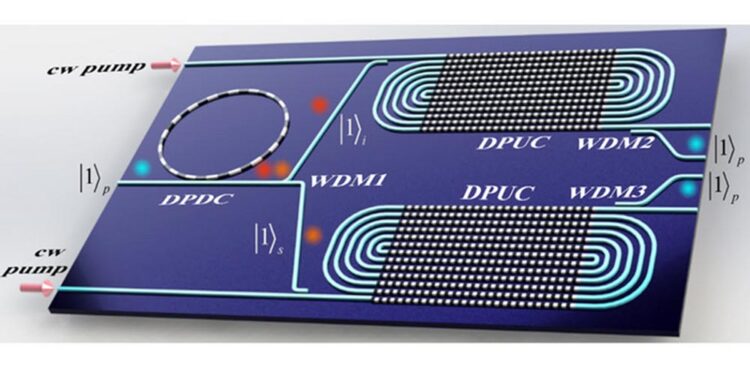Toward practical quantum optics: multiphoton qubits from LNOI

On-chip scheme for deterministic N-photon state generation in LNOI circuit.
Credit: Liu, Shang, et al., doi 10.1117/1.APN.2.1.016003
New research demonstrates feasibility of photon-number doubling with a lithium-niobate-on-insulator (LNOI) platform.
Can quantum optics be used for practical applications? A lot depends on whether a large number of photons can be gathered in quantum state.
Among all quantum systems, photons are known for their weak interaction, which allows long coherence time to be achieved even at room temperature, making them suitable for transmitting quantum bits (also known as “qubits”) between distant locations. However, the weak interaction of photons restricts the generation of quantum states known as multiphotonic qubit states, or “N-photon states.” Generating N-photon states remains a fundamental challenge in the field of quantum optics.
As reported in Advanced Photonics Nexus, researchers from Nanjing University have proposed the first scheme that, in principle, can practically generate an N-photon state deterministically—so that photon number doubling happens with 100 percent efficiency—with unlimited numbers of photons. The scheme is experimentally feasible, taking account of practical material capability by using a lithium-niobate-on-insulator (LNOI) platform, which provides an ultrastrong χ(2) nonlinear interaction.
In the reported scheme, the key component is the photon-number doubling unit (PDU), which can double photon numbers while keeping the spectrum unchanged. In the PDU, the most challenging part is the deterministic conversion from single-photon to bi-photon. It has been proposed and theoretically studied before, but only with an ideal χ(2) or χ(3) material assumption. Based on practical material parameters, the researchers proposed the first experimentally feasible scheme for the PDU process. The team shows that the PDU is universal for generation of N-qubit states for different quantum technology applications, proposing as examples on-chip designs for N-photon Fock state, cluster state, and GHZ state.
Their scheme involves deterministic parametric down-conversion (DPDC) in a high-Q LNOI microring resonator. Combining the ultrahigh nonlinearity of the LNOI platform and the cavity-enhancement effect of the resonator, DPDC can be achieved with 107 Q-factor microring, which is within the current limits of fabrication and experimentation. Besides the DPDC, for scalability, a deterministic parametric upconversion (DPUC) is necessary in the PDU for converting the photon frequency back to pump frequency. They show that this can be achieved with milliwatt-level on-chip power in LNOI circuitry.
As the first experimentally feasible scheme for deterministic N-photon state generation taking account of practical material parameters, the work provides significant guidance for actual realization of large-photon-number states in the future. According to Senior author Zhenda Xie, professor at Nanjing University’s School of Electronic Science and Engineering, “Large-number photon state is regarded as one of the ultimate goals for physicists in quantum optics and quantum information. This work proposes the first feasible scheme to actually achieve the goal.” Xie adds, “Such deterministic single photon interaction based on LNOI may be used not only for photon generation, but also for photon manipulation to realize quantum gates, quantum storage, and so on, to push forward the development of quantum computation, quantum communication, and overall quantum information technology.”
The team anticipates that their optical approach to quantum information will arouse interest and encourage fellow researchers to actually demonstrate it.
Read the Gold Open Access article by Liu, Shang, et al., “Deterministic N-photon state generation using lithium niobate on insulator device,” Adv. Photon. Nexus 2(1), 016003 (2022), doi 10.1117/1.APN.2.1.016003.
Journal: Advanced Photonics Nexus
DOI: 10.1117/1.APN.2.1.016003
Article Title: Deterministic N-photon state generation using lithium niobate on insulator device
Article Publication Date: 15-Dec-2022
Media Contact
Daneet Steffens
SPIE–International Society for Optics and Photonics
daneets@spie.org
Office: 360-685-5478
All latest news from the category: Information Technology
Here you can find a summary of innovations in the fields of information and data processing and up-to-date developments on IT equipment and hardware.
This area covers topics such as IT services, IT architectures, IT management and telecommunications.
Newest articles

Innovative 3D printed scaffolds offer new hope for bone healing
Researchers at the Institute for Bioengineering of Catalonia have developed novel 3D printed PLA-CaP scaffolds that promote blood vessel formation, ensuring better healing and regeneration of bone tissue. Bone is…

The surprising role of gut infection in Alzheimer’s disease
ASU- and Banner Alzheimer’s Institute-led study implicates link between a common virus and the disease, which travels from the gut to the brain and may be a target for antiviral…

Molecular gardening: New enzymes discovered for protein modification pruning
How deubiquitinases USP53 and USP54 cleave long polyubiquitin chains and how the former is linked to liver disease in children. Deubiquitinases (DUBs) are enzymes used by cells to trim protein…



